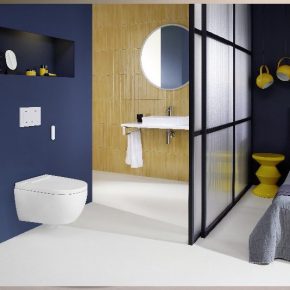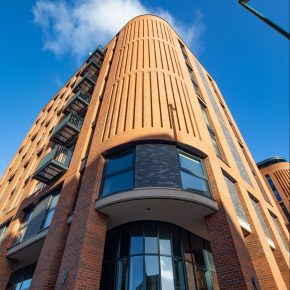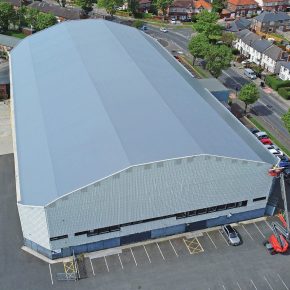
Stannah: Part M – Volume 2 & Wheelchair Platform Stairlifts
This post is the fifth and final in the series of Stannah‘s Part M: Volume 2 building regulations blogs. It covers the detailed requirements for wheelchair platform stairlifts. The company explain more…
What is Part M: Volume 2?
These building regulations refer to the accessibility and use of buildings, Approved Document M (2015 edition) Volume 2 for Buildings other than dwellings (all other building types) and give direction on enabling a public access building to conform to the Equality Act (formerly DDA).
Section three within Part M, vol.2 sets the objective for the horizontal and vertical circulation of people in buildings, first covering the general lifting provisions and design requirements before going into specific requirements for each lift type.
We have outlined the wheelchair platform stairlift requirements below as well as some additional items that are a worthwhile consideration as part of your Part M stairlift.
Using access stairlifts in buildings
Wheelchair stairlifts work by travelling up the flight of a staircase and are generally used in exceptional circumstances, typically within an existing building, provided its installation does not conflict with requirements for means of escape. Often these inclined platform stairlifts are used to provide access to an annexe, or sub-section of a building that can’t be accessed by the main lift.
Platform stairlift design considerations
Though there are general design considerations, there are also some more specific details. Below are the key questions to help ensure the requirements are met.
1. Does the area surrounding the lift enable free and easy movement?
Wheelchair platform stairlifts work by travelling up the flight of a staircase, but it’s important to note that they must not be installed where their operation restricts the safe use of the stairs by other people, in particular, staircases used for evacuation purposes.
As such, there is a minimum stair width that needs to be maintained when the wheelchair platform is in the parked position.
2. What type of configuration do you require?
Wheelchair lifts are in essence all ‘through’ platform lifts, with the ability to have a side access ramp added to aid getting on the lift at the lower level. Whilst travelling and once at the top of its travel, this side ramp does not come down, remaining up, to create a safety ‘tray’, with only the end ramp coming down onto and level with the upper rounded edge of the flight of stairs.
Part “M” requests an 800mm x 1250mm platform size for use in public areas, shops, sports centres and public buildings (libraries, etc). However, lift platform size selection is often based on the available space that the building has, generally, older buildings are not designed to accommodate lifts. Therefore, if a larger or smaller lift platform size is required, approval from building control must be sought as to what is acceptable for the area.
3. Do you require a seating option?

Some disabled people either do not use a wheelchair (as an example, some elderly people with limited mobility), have another chair waiting on the new level, or simply prefer not to travel in the chair.
Weight is also a consideration with some battery-powered wheelchairs exceeding the payload capability. These are not to be confused with mobility scooters, which are generally much heavier and have longer and wider wheelbases for stability. The user must sit in the middle of the lift chair, must be restrained with a seat belt (which can be provided) and must never stand on the platform whilst travelling.
4. What operation do you require?
The majority of wheelchair platform stairlifts are operated by continuous pressure controls, either a button or occasionally a joystick. The rated speed of these types of lifts does not exceed 0.15m/s. Due to the controls and the slow travel between landing, it’s important to note that they may not be suitable for users with certain disabilities, for example, those who become easily fatigued.
It’s essential that wheelchair platform lifts are only to be installed where users can be instructed how to use them safely. Lift users do not always need to be supervised, but, a detailed risk assessment needs to be undertaken in order to ascertain the degree of mobility that the average user has. Typically, category ‘A’ & ‘B’ wheelchair users will be able to operate the lift themselves, but assistance for more seriously disabled people must be on hand if/when required.
The results of the risk assessment will also dictate whether an alarm is necessary, e.g. due to hearing-impaired users, then this will need to be included in the lift specification. It’s also important that the lift is fitted with controls to prevent unauthorised use. This will ensure that fair access is provided for all but also ensures maximum safety at all times.
5. Does your lift comply with the relevant standards?
Lifting platforms must conform to the requirements of the Supply of Machinery (Safety) Regulations 1992. It also needs to comply to BS EN 81-40:2008 or where necessary, by product certification issued by a Notified Body. (Click here to see a glossary of lift standards).
Summary
For each different lift type, there are specific design considerations and provisions outlined in the Approved Document M – Volume 2. So once you know which product you require, it’s always worth stating to your chosen lift supplier that you require a Part M compliant lift or ‘Part M lift’ and they should be able to assist you with the process.
Of course, compliance to Part M is just one of the many factors to evaluate when choosing the right type of lift, or lifts, for your building project. In fact, we have a helpful blog outlining the three key considerations when choosing a lift.
How can Stannah help?
A reputable lift provider will be able to assist you in your decision making, however, it’s certainly worth being well-informed about these design considerations yourself. Here at Stannah, we offer a broad range of platform lift products (and passenger lifts) to enable easy vertical circulation, working with you to solve your access problem and comply with building regulations.
Visit Supplier's page
Latest news

23rd April 2024
Geberit brings Parallel World to Clerkenwell Design Week
Visitors to this year’s Clerkenwell Design Week (21 – 23 May) can step into a parallel world and discover the benefits of cleaning with water, thanks to Geberit.
Posted in Articles, Bathrooms & Toilets, Bathrooms, Bedrooms & Washrooms, Building Industry Events, Building Industry News, Building Products & Structures, Building Services, Exhibitions and Conferences, Innovations & New Products, Interior Design & Construction, Interiors, Plumbing, Restoration & Refurbishment, Retrofit & Renovation
23rd April 2024
Mitsubishi Electric Ecodan Heat Pumps and Water Cylinders to be stocked by The Boiler Shop
Mitsubishi Electric’s full range of Ecodan heat pumps and hot water cylinders are to be stocked by one of the north-west’s best established independent merchants, The Boiler Shop.
Posted in Articles, Building Industry News, Building Products & Structures, Building Services, Facility Management & Building Services, Heating Systems, Controls and Management, Heating, Ventilation and Air Conditioning - HVAC, Plumbing, Posts, Retrofit & Renovation, Sustainability & Energy Efficiency
23rd April 2024
Trio of Senior products used in new Nottingham residential scheme
Solutions from Senior Architectural Systems have helped complete The Barnum – a new residential development on Nottingham’s Queen’s Road.
Posted in Aluminium Products, Articles, Building Industry News, Building Products & Structures, Building Systems, Case Studies, Curtain Walling, Doors, Glass, Glazing, Posts, Restoration & Refurbishment, Retrofit & Renovation, Walls, Windows
22nd April 2024
New EJOT role will develop strategic support for UK flat roofing sector
EJOT UK has taken a major step in the expansion of its support for the flat roofing market by appointing one of its most experienced building envelope fastening specialists as its first sector-dedicated business development manager.
Posted in Articles, Building Industry News, Building Products & Structures, Building Systems, Innovations & New Products, Posts, Recruitment, Restoration & Refurbishment, Retrofit & Renovation, Roofs
 Sign up:
Sign up: